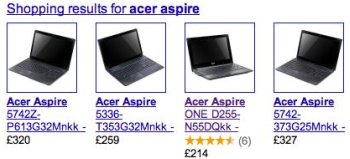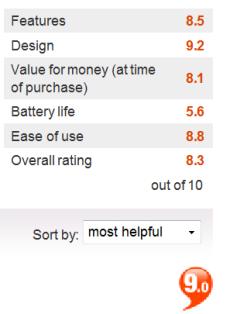User reviews are proven sales drivers, and something the majority of customers will want to see before deciding to make a purchase.
Here are some compelling stats on user reviews, why they are great for SEO, why bad reviews are valuable, and how to use reviews in navigation and on product pages…
Ecommerce: Best Practice Guide (subscribers only)
Why you need customer reviews
There have been so many positive recommendations of the value of reviews for ecommerce, that the case doesn’t really need to be made anymore, though I’ll make it again anyway.
Quite simply, user reviews increase conversions. They can eliminate any doubts potential customers may have about a product, or can help product selection.
We like leaving reviews too. Stats reveal that 47% of Britons have reviewed products online, which suggests there is no shortage of people ready to provide their opinions.
The stats
- According to Reevoo stats, 50 or more reviews per product can mean a 4.6% increase in conversion rates.
- 63% of customers are more likely to make a purchase from a site which has user reviews. (iPerceptions, 2011).
- Site visitors who interact with both reviews and customer questions and answers are 105% more likely to purchase while visiting, and spend 11% more than visitors who don’t interact with UGC. (Bazaarvoice, Conversation Index, Q2 2011).
- Consumer reviews are significantly more trusted (nearly 12 times more) than descriptions that come from manufacturers, according to a survey of US internet users by online video review site EXPO. (eMarketer, February 2010).
- According to Reevoo, reviews produce an average 18% uplift in sales.

The SEO benefits of reviews
Improving conversions and improving customer experience should be the main purpose of user reviews, but let’s not forget the considerable SEO benefits.
These include:
Fresh, unique content for search engines
Search engine spiders like unique content that is regularly updated, and user reviews are a great way to attract more content.
When many ecommerce sites just use the same standard manufacturer descriptions and product specifications, user-generated content can differentiate a product page in the search results.
This is important as it makes pages more useful to customers, and also increases the chance of ranking highly in the SERPs.
Improve rankings for ‘product name’ + review
Reviews are an increasingly important part of the purchase journey for online consumers. Indeed, a recent survey found that 64% of consumers would read online reviews when purchasing technology items such as MP3 players and cameras.
This also means that more consumers will be searching for the name of the product plus the word ‘review’, or related words such as ‘ratings’.
If you have reviews on your site, then you stand a better chance of picking up this traffic. =
Increased CTR on results pages
If review content is correctly formatted, then these rich snippets can help increases clickthroughs from search engine results pages. In the example below, the addition of the star rating makes the third result stand out:

According to stats from Distilled, these rich snippets can mean a 10-20% increase in click-through rates.
Long tail targeting
The additional content generated by user reviews increases the chance of ranking well for long tail searches.
In addition, people leaving reviews tend to use the same language that other people will use when actually searching for them.
Key SEO considerations for user reviews
Indexation
To ensure that search engines reach your user generated content, it must appear in text form in the HTML.
You should also avoid a reliance on JavaScript, cookies, Flash, images, iFrames or other technologies that would limit the accessibility of any content you want the search engines to see.
Non-duplication
Though snippets of reviews could appear on multiple pages, such as on category pages, or promoted via the homepage, it is important that the full review has a single page and a single URL.
Breadth of content
As many pages on the site as possible should feature user reviews to maximise the opportunity to rank well for this content and capitalise on long tail traffic.
Bad reviews are valuable too…
All reviews are valuable, and a mix of positive and negative reviews helps to improve consumer trust in the opinions they read.
Indeed, recent stats from Reevoo suggest that the presence of bad reviews actually improves conversions by 67%.
Reevoo found that people that seek out and read bad reviews convert better, as the very fact that they are paying such close attention means they are more likely to be in purchase mode.
68% of consumers trust reviews more when they see both good and bad scores, while 30% suspect censorship or faked reviews when they don’t see any negative opinions on the page.
Too many bad reviews aren’t good for business
The benefits of bad reviews very much depends on the proportion of good to bad. The negative reviews make the positive ones more believable, but there is a point at which they ring alarm bells for consumers.
If, for instance, a product page contains 15 reviews, and two are negative, then the other 13 look trustworthy. If that proportion changes, it’s a different matter.
Recent research from Lightspeed found that between one and three bad online reviews would be enough to deter the majority (67%) of shoppers from purchasing a product or service.

The tolerance of bad reviews varies depending on age groups. For example, 28% of the 45-54 age group and 33% of 55-64 year olds would be deterred after reading two bad reviews, compared with just 10% of 18 to 24s.
It also depends on the type of product on offer. A book, game or film will often divide opinion, but reviews of electrical products which highlight flaws will be more likely to deter others.
Much depends on the context and the way reviews are displayed, which I’ll look at elsewhere in this post.
How to attract reviews from customers
Guest blogger Mike Essex has listed 20 ways to attract customer reviews, which should provide plenty of ideas.
These include:
Use a reviews provider
One guaranteed method of getting enough customer reviews to make your product pages more persuasive for shoppers is to use a third party reviews provider, such as Reevoo or Bazaarvoice.
Many retailers, including Comet, Tesco, and Argos use these companies to add reviews to their sites. This is a useful way to build up a body of reliable reviews for product pages which could otherwise take some time.
These reviews are also authenticated, so customers know that the person leaving the review has actually purchased the product in question.
Drawbacks include the fact that such reviews tell other potential customers nothing about buying from your site in particular, as reviews are generally syndicated.
Email customers post-purchase
Sending an email after a customer has purchased an item to ask for a review is a good idea, but the timing is a key issue here.
You need to give customers enough time to have received the product and had to chance to start using it and form an opinion, but it still needs to be sent when the purchase is fresh in the customer’s mind.
This is a tactic which has worked for M&S recently. Thanks to including Bazaarvoice reviews functionality in post-purchase emails, M&S has increased customer feedback by more than 400%.
Ask for reviews on product pages
There are plenty of product pages that have yet to attract customer reviews, perhaps because the products are niche, or newly released.
However, if you are attracting reviews from people who haven’t used the product or, as is often the case on Amazon, reviews for items which haven’t even been released, they may be less useful to other shoppers.
Make the process as simple as possible
Some users may not have a lot to say about some products, or may have a limited attention span, so make it nice and easy to leave opinions.
Offering customers the option of leaving a quick rating out of five or ten is one way, and provides a useful summary score to add to product pages, while another way to get a little more useful detail is to ask users to give different aspects of products a rating, as Reevoo does.
This also provides some useful detail for other customers:

Offer incentives for leaving reviews
If a customer has purchased an item, one way to get them to take the time to write a review is to offer an incentive, as Comet does here:

This is possibly best limited to post-purchase emails, so that people aren’t leaving reviews just to enter a competition or receive a discount.
How to present reviews and ratings
It’s great to have lots of reviews, but once the number of reviews gets to a certain point, it’s important to find ways to organise reviews and help other shoppers make sense of them.
Here are some ideas…
Rate this review / was this helpful?
According to UX expert Jared Spool, Amazon’s addition of the question: “was this review helpful to you?” was responsible for $2.7bn of revenue each year.

By asking this simple question, Amazon’s own customers are able to sort the wheat from the chaff. As Jared Spool says:
Amazon quietly bumps the three most helpful reviews to the top. It tries to balance positive and negative reviews, so shoppers get a balanced perspective. An interesting side effect is how these selected reviews get more votes. If they are controversial (in that not everyone agrees they were helpful), their ratio goes down, allowing the most helpful reviews to bubble up past them.
This makes it a self-managing system, letting the reviews people find the most helpful to maintain their standing at the top of the list. The result is an understated implementation that works great.
Average review score summaries
Not every customer will take the time to read reviews, so showing average review scores helps them to get an idea of ratings at a glance.

Use in filtered navigation
Reviews are not only useful on product pages, but they can also help customers in their product selection.
If you have reviews on site, adding a filter by user rating option provides a useful tool for customers:

Kiddicare does this, but also uses reviews and customer feedback to help customers navigate to products according to their pros and best uses:

Online reviews for in store customers
Reviews aren’t just for online purchases, and many will either research online before heading in store, or use their mobiles to find reviews of the products they are considering.
I’ve yet to see examples of this, but using online reviews in stores could work as a sales driver, in the same way that Waterstones and other retailers use staff recommendations.
People are using smartphones to find reviews (and compare prices) anyway, so it makes sense to show reviews, or prompt them to visit your product pages on their mobiles and view reviews.
Using charts to display review information
Like the average review scores, charts like this one from Amazon help users to make sense of large numbers of reviews, and get an idea of the general consensus.
Show some detail
Kiddicare not only gives a rating and shows the customers’ opinions, but also lists pros and cons, best uses, and asks the person leaving the review to describe themselves.
This means that potential customers can view this useful detail at a glance, but it also means that Kiddicare can use this information in its navigation.

For travel sites, use TripAdvisor reviews
TripAdvisor is such a well established of many people’s online travel research that sites should just assume customers will consult it before booking.
One way to keep them on site is to provide TripAdvisor reviews on product pages, with an average rating and a link to read reviews. This is what Best Western does.

These reviews are shown further down the page s that users don’t necessarily have to leave the site.

Use reviews in PPC
Seller ratings provided by customers can be used in PPC ads to provide a quick star rating for searchers.
Here, confused.com’s ratings give it a slight edge over the rest, top position aside.

Use them offline
Kia has used reviews in its offline advertising, in print ads, TV ads, and in showrooms:

(This is an updated version of a post orginally published in 2013).



Comments